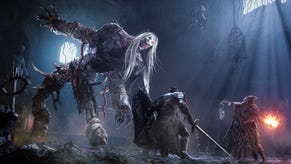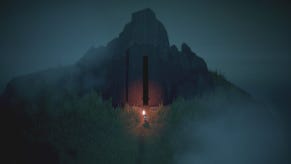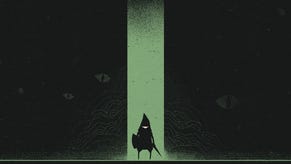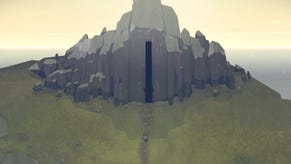Below finally has a release date - and it's next week
Up from the depths.
Below, the long-in-development dungeon crawler from Canadian indie studio Capybara, finally has a release date, and it's very soon. The game will be released on Xbox One and PC (on Steam) in just over a week's time, on Friday 14th December.
Below was first revealed during Microsoft's E3 2013 press conference and has been delayed multiple times, at one point indefinitely. I personally last saw it at GDC in 2016, over two and a half years ago. The game looked good and Capy boss Nathan Vella seemed upbeat. But it was later that year that it was delayed with no new launch window, and everything went quiet.
Below resurfaced at GDC this year, promising a 2018 release. Wes spoke with Vella around that time and he was, mostly, still upbeat.
I met Vella again in a London hotel room last week, where he showed me a near-final build of the game and told me that he would be able to keep his word: Below would make it out in 2018 - just. Vella, tall and genial, looked tired - though that might just have been the jetlag - and confessed to a mixture of anxiety, relief and excitement that the game was finally seeing the light of day.
"I'm, like, terrified, super excited, and really proud of the folks that actually didn't give up on it," he said. "It's a long time to work on a game... actually working on something in the trenches, making assets, figuring stuff out, not giving up on it, that resilience is really the biggest takeaway for me. I kept seeing how much [the team] wanted to get this game out and now that we actually are, I'm pretty stoked for them."
Capy has released other games during Below's development. But although it's a small studio, it's broken up into discrete teams - which means the core of the Below team, under creative director Kris Piotrowski, really has been working on it for six years. It was two or three people at first, then four or five, then scaled up to a team of around 15 in the last six months or so as the end came in sight.
What Vella showed me of Below seemed mostly familiar from previous demos. The game's curse is that its look and concept were so well defined by that 2013 reveal trailer that it has been hard to understand why realising them was taking so long. In fact, almost everything about the game has changed since then: its structure, its scope (it has become "a long game, a big game"), its graphics tech (it moved from predominantly 2D to predominantly 3D as the developers came to realise how important light and shadow were to its gameplay and themes), the way its maps are procedurally generated (which went through four iterations), the depth of its crafting system and the number and complexity of secrets in the game.
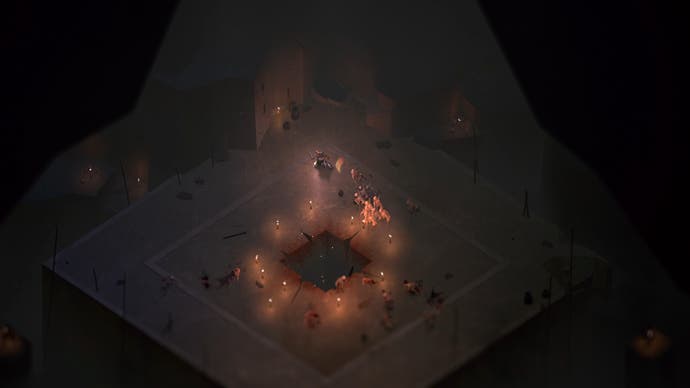
In a way, everything is a secret in Below, a game which contains no text and largely refrains from explaining itself. At times, Vella showed me things that he asked me not to spoil but said I could hint at. In one area, a crumbling catacomb, what I can only describe as a presence could be sensed, something very different from our tiny warrior hero and the skittering but surprisingly dangerous enemies he faced. In a clean, geometrical "temple" - a space powered by a kind of magical technology - reaching the apparent goal made a surprising change to the environment and gameplay.
The game has a strong sense of mystery and awe that reminded me of Fez. Preserving this inscrutable quality while ensuring the game made some sense has been a difficult balancing act, said Vella. "Even something as simple as building the iconography for your backpack and for your map: those are things that for a game like ours require a whole bunch of trial and error and iteration to ensure readability - to ensure that they're clear if you try them, but if you just look at them you might not necessarily understand everything at the first grasp. Because that's not what the game is about."
As Vella played, he frequently fell quiet, concentrating on keeping his character alive when he got hungry or started bleeding, or on the fast-paced, risky combat. From time to time, he even seemed mystified or surprised by what he came across in the procedurally generated maps. He seemed to be enjoying himself, getting sucked in.

"I like to say that I've drunk the Kool-Aid that I helped to make," he said. "We've never made a game before that's about systems, that has a bunch of systems that are supposed to inter-work and complement each other. And that's a big challenge. We're usually a very aesthetic-driven, gameplay-driven, feel-driven studio... and this game is a whole bunch of systems. But sometimes the interaction of those systems that we don't necessarily control is some of my favourite stuff."
Vella said that he is particularly interested to see how people play the game, and how quickly they can discover its secrets. There's a plan to support the game after release with new content if the audience is there.
Making Below has changed Capybara "all the way down to the very core," said Vella. "Everything that we do going forward is going to be shaped by the trials and tribulations of this project." He predicts that the studio's next project will be something very different. But he said it wasn't a difficult decision, or a problem financially, for the studio to keep developing Below over such a long time.
Vella, who became a father during the making of Below, said that it was a very personal game, especially for its director Piotrowski. He also said that had come to see the game's descent into the mysterious depths as a metaphor for its own making. "Kris describes [the creative process] as excavating. You're not sitting there with a magnifying glass trying to fine-tooth-comb stuff. You're literally just taking a shovel and digging. And trying to find what's at the bottom."



